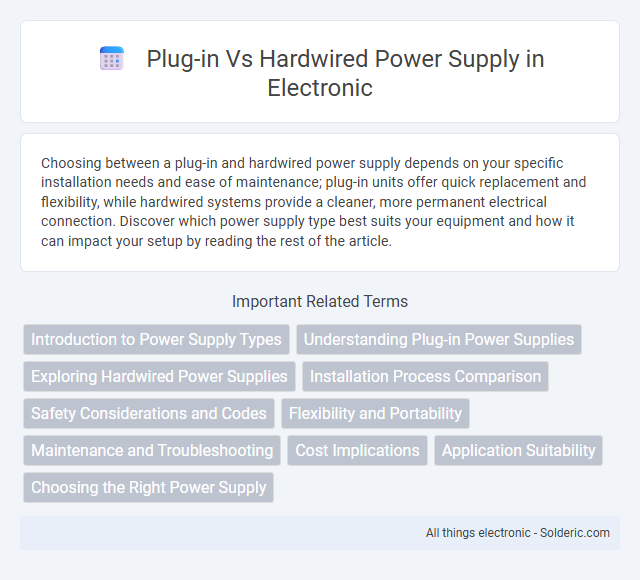Choosing between a plug-in and hardwired power supply depends on your specific installation needs and ease of maintenance; plug-in units offer quick replacement and flexibility, while hardwired systems provide a cleaner, more permanent electrical connection. Discover which power supply type best suits your equipment and how it can impact your setup by reading the rest of the article.
Comparison Table
| Feature | Plug-in Power Supply | Hardwired Power Supply |
|---|---|---|
| Installation | Simple, plug into standard outlet | Requires electrical wiring and mounting |
| Flexibility | Portable and easily replaceable | Permanent, less flexible |
| Cost | Generally lower upfront cost | Higher installation cost |
| Safety | Safer for DIY installation | Must follow electrical codes, professional installation recommended |
| Application | Suitable for small appliances and temporary setups | Best for fixed installations and industrial systems |
| Maintenance | Easy to replace or upgrade | More complex and time-consuming |
| Power Capacity | Limited by plug and outlet ratings | Can handle higher power loads |
Introduction to Power Supply Types
Power supply types include plug-in and hardwired options, each serving different installation needs and applications. Plug-in power supplies feature detachable connectors for easy installation and replacement, commonly used in consumer electronics and temporary setups. Hardwired power supplies are directly connected to electrical wiring, offering a permanent and secure solution suitable for industrial equipment and heavy-duty appliances.
Understanding Plug-in Power Supplies
Plug-in power supplies convert AC voltage to a usable DC voltage through an external power adapter, enhancing portability and ease of replacement. They often include built-in safety features such as overload protection and are suitable for consumer electronics requiring standardized voltage outputs. Compared to hardwired power supplies, plug-ins offer flexibility in power source options and simplified maintenance.
Exploring Hardwired Power Supplies
Hardwired power supplies offer a secure and permanent electrical connection directly wired into a building's circuit, eliminating the risks of accidental disconnection and reducing electrical resistance. They are commonly used in commercial and industrial settings where reliable and stable power delivery is critical to prevent downtime and ensure safety compliance. Unlike plug-in power supplies, hardwired systems provide enhanced durability and are better suited for high-load applications requiring consistent energy flow.
Installation Process Comparison
Plug-in power supplies offer a simple installation process, requiring only connection to a standard outlet and minimal technical knowledge, making them ideal for quick setups. Hardwired power supplies demand professional installation involving securing wiring directly into the building's electrical system, ensuring a more permanent and reliable power source. Your choice depends on the required installation complexity, with plug-in models providing ease and flexibility, while hardwired options deliver durability and integration.
Safety Considerations and Codes
Plug-in power supplies offer enhanced safety through built-in overcurrent and thermal protections, making them compliant with UL, NEC, and IEC safety standards, whereas hardwired power supplies require professional installation to meet local electrical codes and minimize risks such as electrical shock or fire. Adhering to NEC code 725.121 and UL 1310 standards ensures that hardwired units are installed with proper grounding, circuit breakers, and insulation to prevent hazards. Choosing the appropriate power supply type depends on the application's safety requirements and regulatory compliance needs.
Flexibility and Portability
Plug-in power supplies offer superior flexibility and portability due to their detachable design, enabling easy replacement and transport across different devices and locations. Hardwired power supplies, integrated directly into equipment, limit mobility and require professional installation or modification to relocate or replace. Choosing a plug-in model enhances adaptability for users needing frequent moves or upgrades, while hardwired setups prioritize permanent, fixed installations.
Maintenance and Troubleshooting
Plug-in power supplies offer easier maintenance due to their modular design, allowing quick replacement without disrupting the entire system. Troubleshooting is simplified with plug-in models since faulty units can be isolated and swapped independently, minimizing downtime. Hardwired power supplies often require more complex diagnostic procedures and professional intervention, increasing maintenance time and costs.
Cost Implications
Plug-in power supplies generally incur lower upfront costs due to their standardized design and mass production, making them ideal for budget-conscious applications. Hardwired power supplies may involve higher installation expenses and require professional wiring expertise, increasing initial expenditures but offering long-term reliability and reduced maintenance costs. Your choice depends on balancing immediate budget constraints against potential future savings and operational requirements.
Application Suitability
Plug-in power supplies are ideal for applications requiring portability and easy replacement, such as consumer electronics and small appliances where convenience and flexibility are priorities. Hardwired power supplies suit permanent installations in industrial equipment and commercial lighting systems, providing a secure, tamper-resistant connection with higher current capacities. Choosing between plug-in and hardwired power supplies depends on factors like installation environment, maintenance accessibility, and electrical load requirements.
Choosing the Right Power Supply
Choosing the right power supply involves evaluating factors such as installation convenience, safety, and reliability. Plug-in power supplies offer easy installation and portability, making them ideal for temporary or low-power applications, while hardwired power supplies provide a permanent, secure connection with higher current capacity suited for industrial and commercial environments. Consider voltage requirements, power output, and regulatory compliance to ensure optimal performance and safety in your specific use case.
Plug-in vs Hardwired Power Supply Infographic

 solderic.com
solderic.com